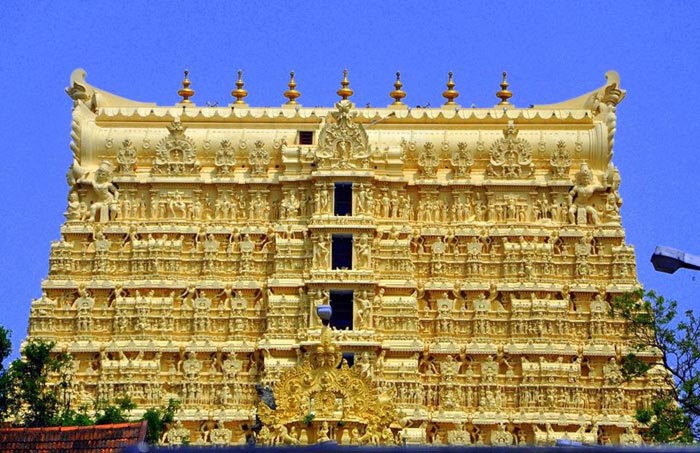Sri Padmanabhaswamy Temple

Information of Sri Padmanabhaswamy Temple, Thiruvananthapuram, Kerala
This temple is one of the most famed, revered and visited temples in all of Kerala. This temple is a replica of the temple Adikesava Perumal which is located in Kanyakumari. The main deity worshipped here is called Padmanabha and only people belonging to the Hindu faith or religion is allowed to enter the temple. The temple depicts a Dravidian style of architecture which is very peculiar as compared to the other temples of Kerala. It is an important temple in the city and thus scores of devotees come here to offer prayer every day.
Sri Padmanabhaswamy Temple Religious Significance
The temple is one of the most visited temples in all of Kerala and is highly respected by those who follow Hinduism. The temple is known for its grand festivals which are held two times in a year other than the numerous other small celebrations of the year. The two main festivals celebrated here are the "Alpashy" festival and the "Panguni" festival. The first festival of Alpashy is held during the months of October-November while the latter one is celebrated takes place during the months of March-April. Both these festivals are celebrated according to the Malayalam calendar and is held for 10 days each. The festival is accompanied by a grand procession on the ninth day where the Maharajah of Travancore escorts the deities of the temple to the sea so that they can be immersed in the sea for purification. The idols that are given this ritualistic bath by immersion in the sea are the ritual idols of Padmanabhaswamy Krishna and Narashima Moorthi.
Navaratri is the annual festival that is celebrated here. This festival carries on for 9 days and during this festival the idols of Saraswati Amman and Kumara Swami are brought in front of the temple in a procession. This temple is a well celebrated event and is attended by devotees in hundreds.
The laksha deepam or the festival of one hundred thousand lamps too is a well celebrated one. This festival is celebrated once every six months which makes much more special. It takes place after 56 days of continuous reading of the Holy Scriptures called Vedas after which the lamps are lit. It is worth to be here during the festival time as one can see the importance of the festival as well as how everything is carried in this famous temple of Kerala.
Sri Padmanabhaswamy Temple Mythology & History
It is said that Vilvamangalathu Swamiyar who stayed near the Ananthapuram temple in Kasargod was praying to Lord Vishnu so that he may get his darshan. The god obliged but he came in the disguise of a small boy which the Swamiyar couldn't recognise. The boy defiled the offerings of the worship that was to be done and this enraged the sage to chase the boy away. The boy disappeared which led the sage to search for him. After long hours search he finally found a Pulaya lady threatening her child that she would throw him into the Ananthankadu. He enquired with the lady about the directions of the Ananthankadu where he saw the boy. He saw the boy merging into an Ilupla tree which then fell down an attained the form of "Anantha Sayani Moorthi" which is Vishnu reclining on Anantha his snake. The lord that the sage saw was of extraordinarily size which had its head in Thiruvallom, Navel at Thiruvananthapuram and feet at Thrippaduram. The sage requested the lord to shrink to thrice the length of his staff which the lord did however the Ilupa trees didn't let him see the entire lord. The swami then prayed to the lord padmanabha for forgiveness. The spot from where the sage got a sight of the lord was turned into a temple which still exists till day.
Sri Padmanabhaswamy Temple Architectural Significance
This temple is consisted of two major parts i.e. the main shrine and Vault B other than the various smaller shrines. The main shrine is dedicated to Padmanabha who can be seen reclining on a serpent. The serpent has five hoods and they face inward, the hand of the main deity rests on a shiva linga and he has his two consorts by his side. The idol of this figure is covered with a special ayurvedic mix called "Katusarkara yogam" which keeps it clean.
The vault is another part of the temple and a total of six vaults are present. Other than these vaults there are two more important shrines of Thekkedom and Thiruvambadi. The thiruvambadi shrine is said to be older than that of the padmanabha and has its own namaskara mandapam, stonemast along with a flag post.
There also is a hundred feet gopuram which is divided into seven tiers and illustrates the Pandyan style architecture. This gopuram is the main entrance of the temple and leads to the temple inside.
- Andhra Pradesh Temples
- Assam Temples
- Bihar Temples
- New Delhi Temples
- Goa Temples
- Gujarat Temples
- Jammu and Kashmir Temples
- Karnataka Temples
- Kerala Temples
- Madhya Pradesh Temples
- Maharashtra Temples
- Odisha Temples
- Punjab Temples
- Rajasthan Temples
- Sikkim Temples
- Tamil Nadu Temples
- Telangana Temples
- Uttar Pradesh Temples
- Uttarakhand Temples
- West Bengal Temples